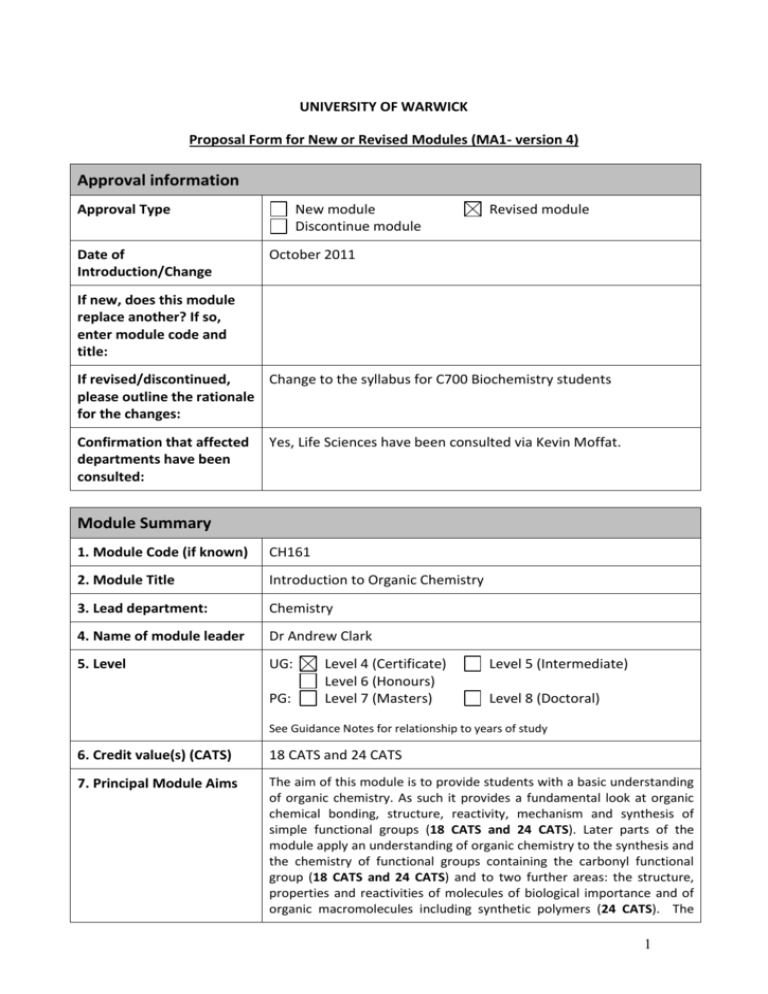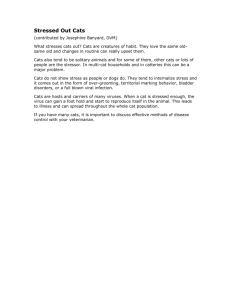UNIVERSITY OF WARWICK
advertisement

UNIVERSITY OF WARWICK Proposal Form for New or Revised Modules (MA1- version 4) Approval information Approval Type Date of Introduction/Change New module Discontinue module Revised module October 2011 If new, does this module replace another? If so, enter module code and title: If revised/discontinued, Change to the syllabus for C700 Biochemistry students please outline the rationale for the changes: Confirmation that affected departments have been consulted: Yes, Life Sciences have been consulted via Kevin Moffat. Module Summary 1. Module Code (if known) CH161 2. Module Title Introduction to Organic Chemistry 3. Lead department: Chemistry 4. Name of module leader Dr Andrew Clark 5. Level UG: PG: Level 4 (Certificate) Level 6 (Honours) Level 7 (Masters) Level 5 (Intermediate) Level 8 (Doctoral) See Guidance Notes for relationship to years of study 6. Credit value(s) (CATS) 18 CATS and 24 CATS 7. Principal Module Aims The aim of this module is to provide students with a basic understanding of organic chemistry. As such it provides a fundamental look at organic chemical bonding, structure, reactivity, mechanism and synthesis of simple functional groups (18 CATS and 24 CATS). Later parts of the module apply an understanding of organic chemistry to the synthesis and the chemistry of functional groups containing the carbonyl functional group (18 CATS and 24 CATS) and to two further areas: the structure, properties and reactivities of molecules of biological importance and of organic macromolecules including synthetic polymers (24 CATS). The 1 Module Summary content of this module will be assumed in ALL subsequent Chemistry modules. It provides all entering first years with a common foundational knowledge of organic chemistry. This will be achieved by a range of teaching methods, primarily lectures and tutorials, but also student centered learning:-including directed reading, problems classes and workshops, set exercises, and computational exercises 8. Contact Hours (summary) Lectures 50hrs in total (39 for 18 CATS) Workshops 4hrs in total (2 for 18 CATS) Tutorials 7hrs in total (5 for 18 CATS) Non Assessed Class Test 1hr (1 for 18 and 24 CATS) 9. Assessment methods (summary) 100 Examination 3hrs (2 hrs for 18 CATS) 2 Module Context 10. Please list all departments involved in the teaching of this module. If taught by more than one department, please indicate percentage split. Chemistry 100% 11. Availability of module Degree Code Title F100 F101 F105 F106 F107 F108 F121 Chemistry BSc Chemistry BSc with Intercalated Year Chemistry MChem Chemistry MChem with Prof Experience Chemistry MChem with Intercalated Year Chemistry MChem with Industrial Training Chemistry with Medicinal Chemistry BSc Chemistry with Medicinal Chemistry BSc with Intercalated Year Chemistry with Medicinal Chemistry MChem Chemistry with Medicinal Chemistry MChem with Prof Experience Chemistry with Medicinal Chemistry MChem with Intercalated Year Chemistry with Medicinal Chemistry MChem with Industrial Training Chemistry with Management BSc Chemistry with Management BSc with Intercalated Year Biomedicinal Chemistry BSc Biomedicinal Chemistry BSc with Intercalated Year Chemical Biology MChem Chemical Biology MChem with Intercalated Year Biochemistry BSc F122 F125 F126 F127 F128 F1N1 F1N2 BF91 B9F1 FC11 F1C1 C700 Study Year C/OC/ A/B/C Credits 1 1 1 1 1 1 1 C C C C C C C 24 CATS 24 CATS 24 CATS 24 CATS 24 CATS 24 CATS 24 CATS 1 C 24 CATS 1 C 24 CATS 1 C 24 CATS 1 C 24 CATS 1 C 24 CATS 1 C 24 CATS 1 C 24 CATS 1 C 24 CATS 1 C 24 CATS 1 C 24 CATS 1 C 24 CATS 1 C 18 CATS 18/24 CATS Visiting Students O 12. Minimum number of registered students required for module to run 10 13. Pre- and Post-Requisite Modules Post-Requisite Modules CH264 Organic Chemistry II CH248 Organic Synthesis CH242 Polymer Chemistry 3 Module Context CH269 Introduction to Biological and Medicinal Chemistry Module Content and Teaching 14. Teaching and Learning Activities Lectures Workshops 50hrs in total (39 for 18 CATS) 4hrs in total (2 for 18 CATS) Tutorials Laboratory sessions Total contact hours Module duration (weeks) Other activity 7hrs in total (5 for 18 CATS) (please describe): e.g. distance-learning, intensive weekend teaching etc. 61hrs in total (46hrs for 18 CATS) 23 weeks (17 weeks for 18 CATS) 1hr Non Assessed Class Test (also for 18 CATS) 175hrs of Self Study/Revision/Directed Reading (134hrs for 18 CATS) 15. Assessment Method (Standard) Type of assessment Examinations Assessed essays/coursework Other formal assessment Length 3 Hours (2 Hours for 18 CATS) Words % weighting 100% 16. Methods for providing feedback on assessment. Marks for Examination to be provided via Personal Tutor. 17. Outline Syllabus 1) Drawing of organic structures, nomenclature and functional groups. Organic chemical structures, e.g. orbitals, shape, hybridisation, stereochemistry, isomerism 2) Cation/Anion stability, resonance, Acidity, basicity, pKa 3) Mechanism and curly arrows, electrophiles, nucleophiles, radicals 4) Radical stability, mechanism 5) Acidity, free energy diagrams, reaction profiles 6) Substitution mechanisms, SN1, SN2 7) Addition reactions 8) Elimination reactions and chemistry of alkenes and alkynes 9) Chemistry of alcohols, ethers, amines, oxidation and reduction 10) Aromatic electrophilic substitution 11) Carbonyl chemistry, addition, substitution 12) Hydrolysis reactions 13) Grignards, Alkyl lithiums, conjugate addtions 14) Carbonyl enolate chemistry 15) Claisen condensations, aldol condensation, mannuch reactions 16) 1,3-Dicarbonyl compounds and reactions 17) Biomolecules, aminoacids, peptides, proteins 4 Module Content and Teaching 18) Biomolecules, DNA, RNA 19) Lipids, fatty acid synthesis, detergents 20) Macromolecules, synthetic polymers, addition polymerisation, condensation polymerisation Topics 1-16 are covered in the 18 CATS module and topics 1-20 are covered in the 24 CATS module 18. Illustrative Bibliography Essential Text (required) Mechanism in Organic Chemistry, 6th Edition, Peter Sykes, Longman Clayden, Greeves, Warren and Wothers, Organic Chemistry, Oxford 2001 19. Learning outcomes Successful completion of the module leads to the learning outcomes. The learning outcomes identify the knowledge, skills and attributes developed by the module. Learning Outcomes should be presented in the format ”By the end of the module students should be able to...” using the table at the end of the module approval form: Resources 20. List any additional requirements and indicate the outcome of any discussions about these. Approval 21. Module leader’s signature Dr Andrew Clark 22. Date of approval 21st April 2011 23. Name of Approving Committee (include minute reference if applicable) LTC 24. Chair of Committee’s signature Prof Rob Deeth (on behalf of Dr Andrew Clark) 25. Head of Department(s) Signature Prof Mike Shipman 5 Examination Information A1. Name of examiner (if different from module leader) A2. Indicate all available methods of assessment in the table below % Examined % Assessed by other methods 100 Length of examination paper 3hrs/2hrs A3. Will this module be examined together with any other module (sectioned paper)? If so, please give details below. A4. How many papers will the module be examined by? A5. When would you wish the exam take place (e.g. Jan, April, Summer)? 1 paper 2 papers Summer A6. Is reading time required? Yes No A7. Please specify any special exam timetable arrangements. A8. Stationery requirements No. of Answer books? 4 Graph paper? no Calculator? yes Any other special stationery requirements (e.g. Data books, tables etc)? Periodic table and data sheet A9. Type of examination paper Seen? Yes No Open Book? Yes No Restricted? Yes No If restricted, please provide a list of permitted texts: 6 LEARNING OUTCOMES (By the end of the module the student should be able to....) Which teaching and learning methods enable students to achieve this learning outcome? (reference activities in section 15) Which summative assessment method(s) will measure the achievement of this learning outcome? (reference activities in section 16) Lectures, tutorials, workshops, directed reading Formative assessment by set and marked work for tutorials and workshops, summative assessment by examinations. Non assessed class test Lectures, tutorials, workshops, directed reading Formative assessment by set and marked work for tutorials and workshops, summative assessment by examinations Demonstrate an understanding of the structure, shape, properties and reactivity of organic molecules including their acidity, mechanisms and reactions (18 and 24 CATS) Demonstrate an understanding and awareness of different reactions in organic chemistry and why and how they take place. Non assessed class test Have a basic understanding of mechanisms and their stereochemical consequences of nucleophilic substitution, elimination, electrophilic additions/substitutions, oxidations and reduction. (18 and 24 CATS) Have a basic understanding of mechanisms carbonyl and enolate chemistry (18 and 24 CATS) Lectures, tutorials, workshops, directed reading Formative assessment by set and marked work for tutorials and workshops, summative assessment by examinations 8 LEARNING OUTCOMES (By the end of the module the student should be able to....) Use their knowledge of general mechanism and reactivity to postulate mechanisms of organic reactions using curly arrows (18 and 24 CATS) Which teaching and learning methods enable students to achieve this learning outcome? (reference activities in section 15) Which summative assessment method(s) will measure the achievement of this learning outcome? (reference activities in section 16) Lectures, tutorials, workshops, directed reading Formative assessment by set and marked work for tutorials and workshops, summative assessment by examinations Non assessed class test Formative assessment by set and marked work for tutorials and workshops, summative assessment by examinations Lectures, tutorials, workshops, directed reading Use their knowledge to be able to design short syntheses of organic molecules (18 and 24 CATS) Understand the roles of lipids, aminoacids, and DNA in biological chemistry and their structure, reactivity, synthesis and physical properties. Lectures, tutorials, workshops, directed reading Formative assessment by set and marked work for tutorials and workshops, summative assessment by examinations Lectures, tutorials, workshops, directed reading Formative assessment by set and marked work for tutorials and workshops, summative assessment by examinations Demonstrate a knowledge of fatty acid biosynthesis (24 CATS) Understand the basic principles of macromolecules, including the structure, reactivity and properties of synthetic and natural polymers. (24 CATS) 9





